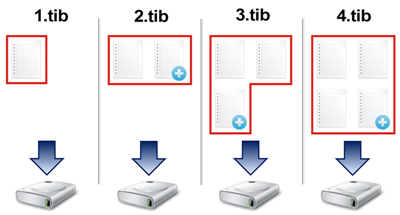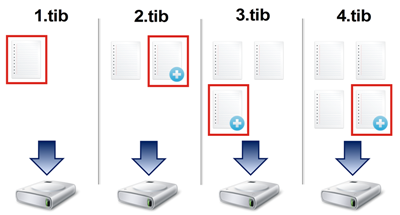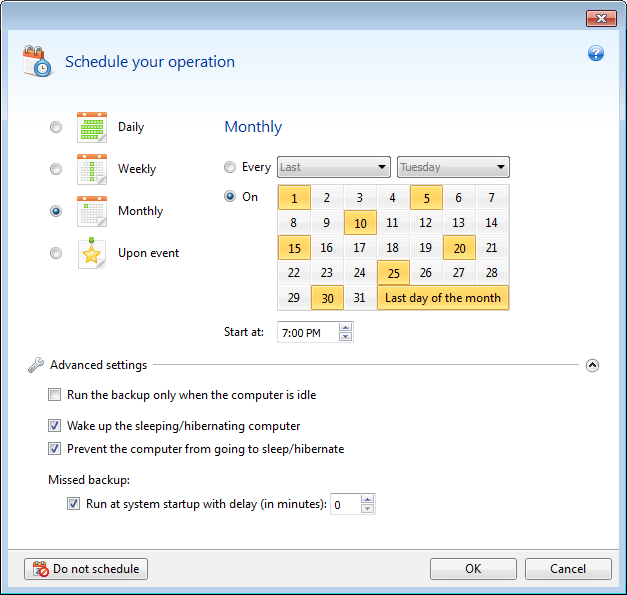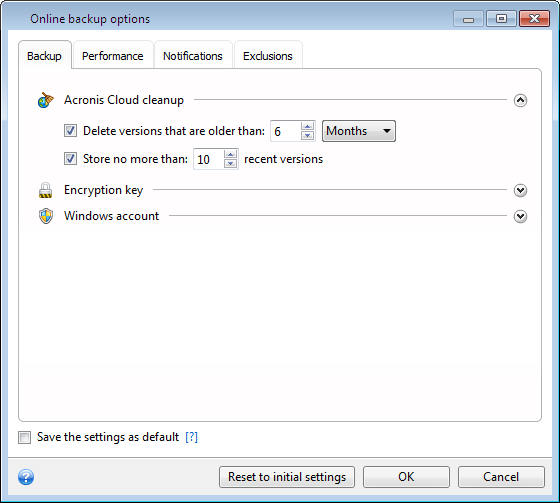Acronis True Image: backup strategies
I greet you, the inhabitants of the habro-world! We continue to introduce you to True Image technologies. This time we’ll talk about how to configure the backup process so that
In part, we already touched on this topic in the Acronis True Image article , ways to create backups . Let's consider it in more detail.
The backup strategy consists of two stages:
In fact, the average user practically does not have to deal with these issues. The default settings are quite suitable for most cases. However, it is obvious that they cannot take into account the specifics of the data of a particular user, how often he changes these data, etc. Therefore, fine-tuning is recommended to be carried out by yourself.
Creating a scheme begins with an understanding of backup methods. There are three such methods: full, incremental and differential backup (full, incremental, differential backup). Why are they needed and what is the difference? We look.
Everything is very simple here. The backup file contains all the data that was selected for backup.

In the picture: all backups are full.
Such backups are the most reliable, but also the largest. At the same time, only one file is required for recovery.
Only changes that have occurred since the last backup are recorded in the backup file.

In the picture: 1.tib - full backup (the first backup is always full), 2.tib, 3.tib, 4.tib - incremental backups.
Incremental backups are much less complete. However, restoration will require a previous full backup (1.tib in the figure) and the entire chain of incremental backups ending with the backup from which you want to restore data.
Only changes that have occurred since the last full backup are recorded in the backup file.

In the picture: 1.tib - full backup (the first backup is always full), 2.tib, 3.tib, 4.tib - differential backups.
Differential backups are less than full, but more incremental. To restore, you need the differential backup itself and the previous full backup (in the figure - 1.tib).
Well, here we come to the most interesting. Of course, you already guessed. Three backup methods give us a lot of all kinds of options for the so-called backup chains. A chain is one complete backup and all incremental and / or differential backups that depend on it. The scheme consists of one or several chains, and also contains rules for deleting old backups.
Indeed, there can be a great many options for chains. But this is in theory. In practice, only one of the methods is taken as the basis of the chain: full, incremental, or differential.

“Here everything is clear as a white day! Always create full backups! ” - you will say and you will be right. But as always there is one more “but.” Full backups are the most weighty. Don't you mind driving your 2 TB disk backups? Then this is the best solution. But most want maximum reliability and variability with minimal loss of disk space. Therefore, as they say, let's understand. Here with the schemes based on full backups and begin.
Creating only full backups is really the most reliable way to protect data. And to prevent uncontrolled inflation of the backup is also quite possible. You just need to configure the cleaning rules, but more on that below.
The disadvantages of this scheme:
This scheme is recommended to be used to protect the system partition. Three or four full backups will be enough.
With this scheme, one full backup and a chain of incremental ones dependent on it are created. The advantages are obvious - backups are created quickly and weigh a little, i.e. you can afford to recreate them much more than with the scheme with full backups. As a result, you get maximum variability when choosing a recovery point. But there is one serious drawback - low reliability. If any of the backups becomes damaged, all subsequent ones turn into garbage - you cannot recover from them. Is there any way to improve reliability? Yes you can. The easiest way is to create a new full backup after several incremental ones, say after four or five. Thus, we get a scheme with several chains, and damage to one of the chains will not affect the others.
This scheme is universal, it can be used to protect both disks and files.
With this scheme, one full backup and its differential ones are created. This approach combines the advantages of the two previous ones. Since differential backups are less than full and more incremental, you get average variability when choosing a recovery point and a fairly high reliability. But you can’t do without flaws anyway. The farther away the differential backup is from its full backup, the harder it is, and may even exceed the size of a full backup. The solution here is the same as with the incremental approach - dilute your differential backups with complete ones. Depending on the rate of change of the protected data, a new full backup is recommended to be created after two to five differential backups.
This scheme can protect your system partition if the disk space does not allow you to store several full backups.
Everything is simple here. You make a schedule, and True Image updates backups for you exactly at the time you set and in accordance with the configured scheme. The more often the data changes, the more often it is recommended that they be backed up. For example, the system partition can be backed up once a month, but the files you work with every day are recommended to be backed up every day or even more often.

Of course, when you urgently need to create a backup, it is not necessary to wait for the planned time. You can always start a backup manually.
Practice shows that users rarely think about cleaning up when setting up backups. But in vain. After all, then they discover that the backup has "eaten" all the free gigabytes of the disk.
Cleaning rules can and should be configured when creating a backup scheme. You can configure as many as three criteria:
Why in the settings are we talking about chains, and not about individual backups? Because the purpose of cleaning rules is to remove obsolete backups. Since any chain starts with a full backup, it is he who becomes the first to become obsolete. When you delete the full, as you know, addicts become useless, so the whole chain is deleted.
Everything that we have talked about so far refers to backups that you store on your internal or external hard drive, on a NAS, FTP server, etc. What about backup to the cloud? True Image saves both file and disk backups in Acronis Cloud in a simple incremental scheme - one full backup and a chain of incremental ones - and does not allow changing it. The reasonable question “why” is simple - this scheme is the most frugal to disk space, and Acronis guarantees the backups in the cloud.
The rules for clearing a cloud backup are a little simpler than usual.

You can limit the backup by "age" and by the number of versions of each of the files that are stored in the cloud. Limiting backup by storage volume would not be very logical. Indeed, first of all, Acronis Cloud is used specifically for storing backups.
So, what do we get in the dry residue. Decide for yourself:
Based on this, configure the backup scheme, planning and cleaning rules. All. Everything else will be taken care of by Acronis True Image.
- data was protected.
- the backup folder (they are backups, they are also backups) did not “eat” all the free space of your disk.
- Do not duplicate the same information in different backups.
In part, we already touched on this topic in the Acronis True Image article , ways to create backups . Let's consider it in more detail.
The backup strategy consists of two stages:
- Creating a backup scheme.
- Backup scheduling
In fact, the average user practically does not have to deal with these issues. The default settings are quite suitable for most cases. However, it is obvious that they cannot take into account the specifics of the data of a particular user, how often he changes these data, etc. Therefore, fine-tuning is recommended to be carried out by yourself.
Methods for creating backups
Creating a scheme begins with an understanding of backup methods. There are three such methods: full, incremental and differential backup (full, incremental, differential backup). Why are they needed and what is the difference? We look.
Full backup
Everything is very simple here. The backup file contains all the data that was selected for backup.

In the picture: all backups are full.
Such backups are the most reliable, but also the largest. At the same time, only one file is required for recovery.
Incremental backup
Only changes that have occurred since the last backup are recorded in the backup file.

In the picture: 1.tib - full backup (the first backup is always full), 2.tib, 3.tib, 4.tib - incremental backups.
Incremental backups are much less complete. However, restoration will require a previous full backup (1.tib in the figure) and the entire chain of incremental backups ending with the backup from which you want to restore data.
Differential backup
Only changes that have occurred since the last full backup are recorded in the backup file.

In the picture: 1.tib - full backup (the first backup is always full), 2.tib, 3.tib, 4.tib - differential backups.
Differential backups are less than full, but more incremental. To restore, you need the differential backup itself and the previous full backup (in the figure - 1.tib).
Chains and schemes
Well, here we come to the most interesting. Of course, you already guessed. Three backup methods give us a lot of all kinds of options for the so-called backup chains. A chain is one complete backup and all incremental and / or differential backups that depend on it. The scheme consists of one or several chains, and also contains rules for deleting old backups.
Indeed, there can be a great many options for chains. But this is in theory. In practice, only one of the methods is taken as the basis of the chain: full, incremental, or differential.

“Here everything is clear as a white day! Always create full backups! ” - you will say and you will be right. But as always there is one more “but.” Full backups are the most weighty. Don't you mind driving your 2 TB disk backups? Then this is the best solution. But most want maximum reliability and variability with minimal loss of disk space. Therefore, as they say, let's understand. Here with the schemes based on full backups and begin.
Schemes based on full backups
Creating only full backups is really the most reliable way to protect data. And to prevent uncontrolled inflation of the backup is also quite possible. You just need to configure the cleaning rules, but more on that below.
The disadvantages of this scheme:
- It takes a lot of time to create each backup.
- Significant waste of disk space.
- A small number of backups, i.e. points in time to which you can "roll back".
- Duplication of the same information in different backups.
This scheme is recommended to be used to protect the system partition. Three or four full backups will be enough.
Incremental backup schemes
With this scheme, one full backup and a chain of incremental ones dependent on it are created. The advantages are obvious - backups are created quickly and weigh a little, i.e. you can afford to recreate them much more than with the scheme with full backups. As a result, you get maximum variability when choosing a recovery point. But there is one serious drawback - low reliability. If any of the backups becomes damaged, all subsequent ones turn into garbage - you cannot recover from them. Is there any way to improve reliability? Yes you can. The easiest way is to create a new full backup after several incremental ones, say after four or five. Thus, we get a scheme with several chains, and damage to one of the chains will not affect the others.
This scheme is universal, it can be used to protect both disks and files.
Schemes based on differential backups
With this scheme, one full backup and its differential ones are created. This approach combines the advantages of the two previous ones. Since differential backups are less than full and more incremental, you get average variability when choosing a recovery point and a fairly high reliability. But you can’t do without flaws anyway. The farther away the differential backup is from its full backup, the harder it is, and may even exceed the size of a full backup. The solution here is the same as with the incremental approach - dilute your differential backups with complete ones. Depending on the rate of change of the protected data, a new full backup is recommended to be created after two to five differential backups.
This scheme can protect your system partition if the disk space does not allow you to store several full backups.
Planning
Everything is simple here. You make a schedule, and True Image updates backups for you exactly at the time you set and in accordance with the configured scheme. The more often the data changes, the more often it is recommended that they be backed up. For example, the system partition can be backed up once a month, but the files you work with every day are recommended to be backed up every day or even more often.

Of course, when you urgently need to create a backup, it is not necessary to wait for the planned time. You can always start a backup manually.
Cleaning rules
Practice shows that users rarely think about cleaning up when setting up backups. But in vain. After all, then they discover that the backup has "eaten" all the free gigabytes of the disk.
Cleaning rules can and should be configured when creating a backup scheme. You can configure as many as three criteria:
- The maximum "age" of backup chains.
- The maximum number of backup chains.
- The maximum total backup size.
Why in the settings are we talking about chains, and not about individual backups? Because the purpose of cleaning rules is to remove obsolete backups. Since any chain starts with a full backup, it is he who becomes the first to become obsolete. When you delete the full, as you know, addicts become useless, so the whole chain is deleted.
What about backup to cloud storage?
Everything that we have talked about so far refers to backups that you store on your internal or external hard drive, on a NAS, FTP server, etc. What about backup to the cloud? True Image saves both file and disk backups in Acronis Cloud in a simple incremental scheme - one full backup and a chain of incremental ones - and does not allow changing it. The reasonable question “why” is simple - this scheme is the most frugal to disk space, and Acronis guarantees the backups in the cloud.
The rules for clearing a cloud backup are a little simpler than usual.

You can limit the backup by "age" and by the number of versions of each of the files that are stored in the cloud. Limiting backup by storage volume would not be very logical. Indeed, first of all, Acronis Cloud is used specifically for storing backups.
So, what do we get in the dry residue. Decide for yourself:
- How much data you want to protect.
- How often will these data change.
- How much free space are you willing to give for backups.
Based on this, configure the backup scheme, planning and cleaning rules. All. Everything else will be taken care of by Acronis True Image.
